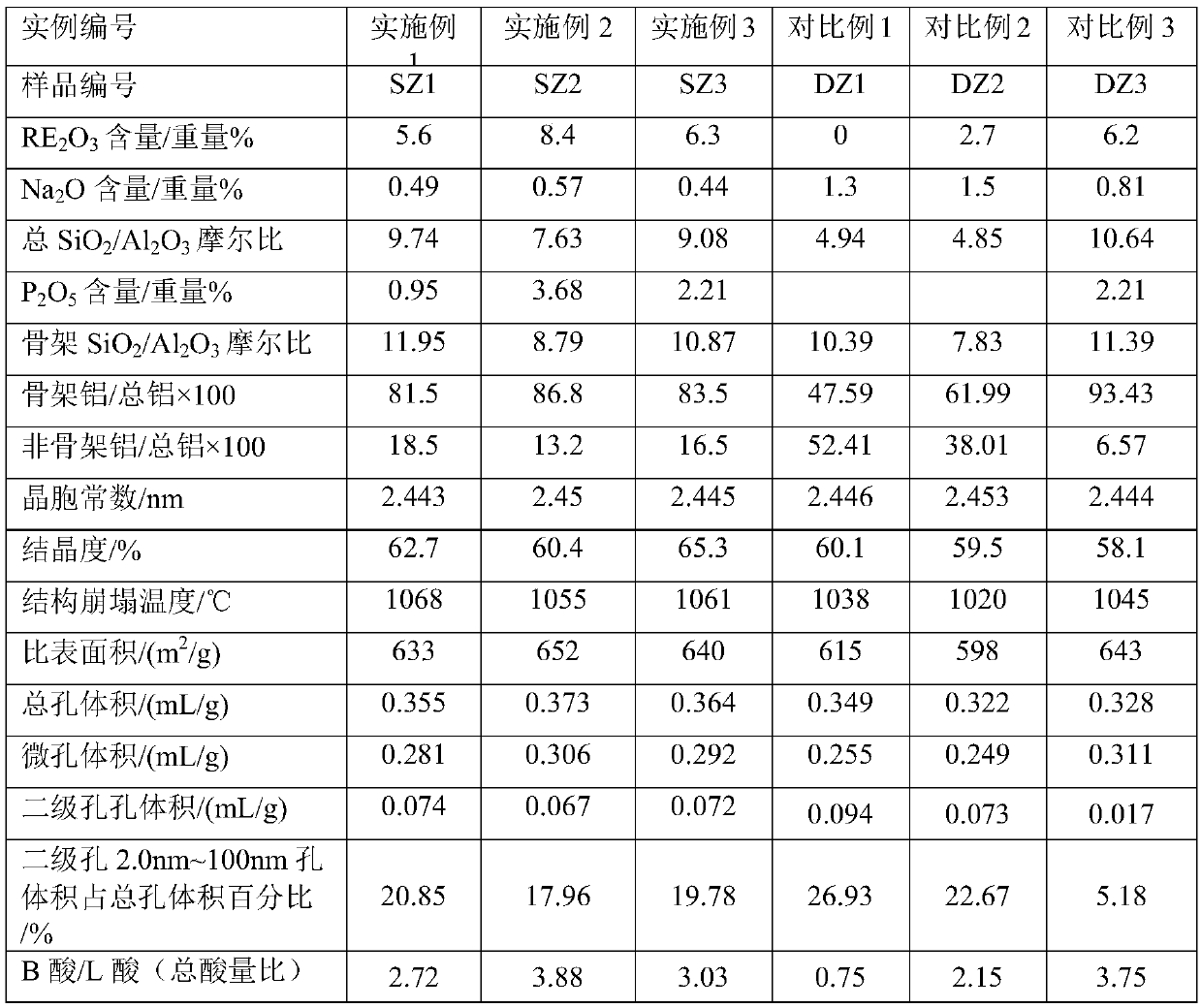Petroleum hydrocarbon catalytic cracking catalyst
A technology of catalytic cracking and petroleum hydrocarbons, applied in catalytic cracking, physical/chemical process catalysts, molecular sieve catalysts, etc., can solve the problems of poor coke selectivity, cracking activity and low gasoline yield
- Summary
- Abstract
- Description
- Claims
- Application Information
AI Technical Summary
Problems solved by technology
Method used
Image
Examples
Embodiment approach
[0050] In the preparation method of the catalytic cracking catalyst provided by the present invention, the preparation method of the ultra-stable Y-type molecular sieve containing phosphorus and rare earths, an embodiment comprises the following steps:
[0051] (1) carry out ion exchange reaction with NaY molecular sieve (also claiming NaY zeolite) and rare earth solution, filter, wash, obtain the Y-type molecular sieve of the conventional unit cell size containing rare earth that sodium oxide content reduces; Said ion exchange is usually stirred, Exchange at a temperature of 15-95°C, preferably 65-95°C, for 30-120 minutes;
[0052] (2) Calcining Y-type molecular sieves with rare earth-containing conventional unit cell size at a temperature of 350-480° C. and containing 30-90% by volume of water vapor for 4.5-7 hours and drying to obtain crystals with reduced sodium oxide content. A Y-type molecular sieve with a reduced cell constant; the cell constant of the Y-type molecular ...
Embodiment 1
[0066] Get 2000 grams of NaY molecular sieves (calculated on a dry basis) and add them to 20 liters of decationized water and stir to make them evenly mixed. Add 600ml of RE(NO 3 ) 3 Solution (rare earth solution concentration is RE 2 o 3 Calculated as 319g / L), stirred, heated to 90-95°C and kept for 1 hour, then filtered, washed, and the filter cake was dried at 120°C to obtain a unit cell constant of 2.471nm and a sodium oxide content of 7.0% by weight. 2 o 3 A Y-type molecular sieve with a total rare earth content of 8.8% by weight is then calcined for 6 hours at a temperature of 390°C in an atmosphere containing 50% by volume of water vapor and 50% by volume of air to obtain a Y-type molecular sieve with a unit cell constant of 2.455nm. After cooling, Add molecular sieves to 6 liters of aqueous solution containing 35 grams of phosphoric acid, raise the temperature to 90°C, and perform phosphorus modification treatment for 30 minutes. After that, filter and wash the mole...
Embodiment 2
[0069] Take 2000 grams of NaY molecular sieves (calculated on a dry basis) and add them to 25 liters of decationized water and stir to make them evenly mixed. Add 800ml of RECl 3 solution (in RE 2 o 3 The calculated solution concentration is: 319g / L), stirred, heated up to 90-95°C for 1 hour, then filtered, washed, and the filter cake was dried at 120°C to obtain a unit cell constant of 2.471nm and a sodium oxide content of 5.5% by weight , with RE 2 o 3 A Y-type molecular sieve with a total rare earth content of 11.3% by weight was then calcined at a temperature of 450° C. under 80% water vapor for 5.5 hours to obtain a Y-type molecular sieve with a unit cell constant of 2.461 nm. After cooling, the molecular sieve was added to a solution containing 268 grams of In 6 liters of ammonium phosphate aqueous solution, the temperature was raised to 60°C, and the phosphorus modification treatment was carried out for 50 minutes. After that, the molecular sieve was filtered and was...
PUM
| Property | Measurement | Unit |
|---|---|---|
| Cell constant | aaaaa | aaaaa |
| Cell constant | aaaaa | aaaaa |
| Cell constant | aaaaa | aaaaa |
Abstract
Description
Claims
Application Information
 Login to View More
Login to View More - R&D
- Intellectual Property
- Life Sciences
- Materials
- Tech Scout
- Unparalleled Data Quality
- Higher Quality Content
- 60% Fewer Hallucinations
Browse by: Latest US Patents, China's latest patents, Technical Efficacy Thesaurus, Application Domain, Technology Topic, Popular Technical Reports.
© 2025 PatSnap. All rights reserved.Legal|Privacy policy|Modern Slavery Act Transparency Statement|Sitemap|About US| Contact US: help@patsnap.com



